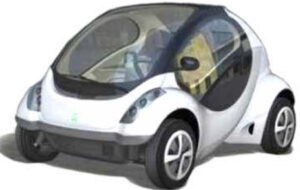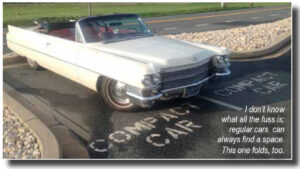

How the Folding Electric Vehicle Went From ‘Car of the Future’ To ‘Obsolete’
Lauren Frayer and Franklyn Cater reported in NPR’s Cities Project in November 2015 about still another electric car demise, this one with a twist– it folded up smaller than a Smart Car. The whole thing was such a joke, I won’t even need to add my usual sarcasm, so I’ll just quote the essence of the article. NPR is big on this climate change business, and is rarely cynical about such things. In fact, this is one of those stories Greenies often ‘forget’ to report. NPR did.
“There was a lot of excitement in 2012, when the Hiriko car was unveiled at an event at European Union headquarters in Brussels. At the time, the then-president of the European Commission, Jose Manuel Barroso, hailed the car as a trans-Atlantic “exchange between the world of science and the world of business.”
A few years ago, engineers at the Massachusetts Institute of Technology debuted a design, a decade in the making, for a car that would transform urban transportation. They called it the CityCar. It’s a small, electric two-seat pod, with “robot wheels.” It looks like a futuristic Volkswagen Beetle. With zero tailpipe emissions, the idea was that it would not pollute. With four wheels that maneuver 120 degrees individually, it could turn on a dime. The door is on the front. So, when parked front-end-in, drivers and passengers could avoid stepping into traffic. And the whole car would fold up — to 60 inches —almost half the size of a Smart Car.
Kent Larson, director of MIT’s City Science Initiative, says the CityCar was a complete rethink of the automobile, aimed at making cities more livable. In 2008, a consortium of small companies in Spain got together to transform the CityCar into a commercial reality.
They renamed the car “Hiriko,” which means “Urban” in the Basque language, Euskera. Entrepreneurs created a nonprofit parent company, Afypaida, to manage public money pouring into the project.
At the height of Spain’s economic crisis, the Spanish government pledged some $16 million, and the Basque local authorities gave about $2.2 million. The European Union also devoted millions from a European social fund, for a total Hiriko budget exceeding $80 million.
“This is a small, folding and smart electric car, but it is also much more than that. It is European social innovation at its best,” said the then-president of the European Commission, Jose Manuel Barroso, at the 2012 event debuting the car in Brussels.
Barroso climbed into the car and got a demonstration from Jesus Echave, the Spanish chairman of the Hiriko consortium. Cameras clicked and both men beamed.
That was 2012. Now three years later, Echave and six associates have been placed under formal investigation for alleged misuse of public funds and falsifying documents. Afypaida ceased operations in April 2013, and laid off all of its employees, some of whom are now suing for severance pay. The company is currently in receivership, with its assets frozen.
Ex-employees of Hiriko have since come forward to say that pieces of the prototype debuted in Brussels were held together with Velcro and superglue.
The seven officials under investigation are in hiding.
“They’re politically well-connected businessmen with no prior experience building electric cars. They used this public money to line their own pockets,” says Igor Lopez de Munain, a member of the Basque parliament who has been investigating the Hiriko case. “I believe they never had plans to bring these cars to market. It was all theater!
People involved with the Hiriko project said several prototypes were built in Spain. Efforts were made to track down the original, which was based on the MIT design, but it has disappeared.
The whereabouts of the Hiriko car remain a mystery.” -NPR 11/5/15
Like I said, man, it’s all a sham. – Frank
